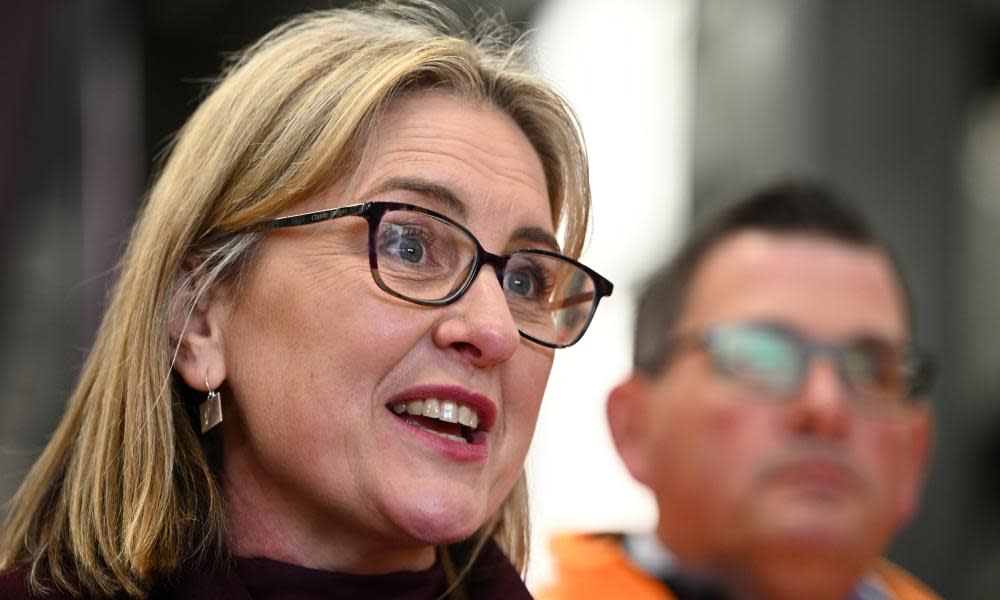‘We’ve come such a long way’: Labor’s Jacinta Allan on pushing gender equality forward in Victoria

As the likely successor to Daniel Andrews, Jacinta Allan is prepared for a lot of things. But seeing a premier tweeting about tampons was something she could never have fathomed when she was first elected two decades ago.
“We’ve come such a long way in the time I’ve been in parliament,” she says.
Her election as Labor’s deputy leader in June was seen as a possible move to take over the party’s leadership when Andrews decides to retire – one that seemingly defied factional convention.
But Allan has long been suggested as a potential premier. She was of six women who won seats off the Liberals at the 1999 election, when Labor’s Steve Bracks defeated the then premier Jeff Kennett in a shock victory. She was the youngest woman to be elected to Victoria’s parliament, having turned 26 a day after the poll.
Related: Victoria election 2022: teal candidates launch legal action over rejected how-to-vote cards
“I remember there weren’t that many women’s bathrooms in the parliament because there just hadn’t been a lot of women up until that point,” Allan says.
Now, Victorian Labor’s leadership group is now more than 50% women and there are 14 women in cabinet, the most of any Australian jurisdiction.
Allan credits this for bringing about Labor’s $71m election commitment to overhaul women’s health services across the state, announced on Tuesday, and an earlier $23m pledge to roll out free pads and tampons in public places in an Australian-first move.
If Labor is re-elected on 26 November, $58m will be spent to create 20 comprehensive women’s health clinics across Victoria offering treatment for conditions such as endometriosis, pelvic pain, polycystic ovary syndrome, perimenopause and menopause.
The premier on Wednesday also announced an additional $64.8m to double the number of endometriosis surgeries in the public system, $5m to create a Women’s Health Research Institute and $3m to establish an inquiry into women’s pain management to examine systemic issues.
“We hear Victorian women, we believe Victorian women and we’re going to take better care of Victorian women,” Andrews said.
Allan doesn’t understate the importance of such care: she was diagnosed with endometriosis at about the time she began her political career.
“Looking back, when I was a teenager and younger woman, I had terrible period pain and really difficult experiences that had to be regulated with medication and there was an embarrassment to it. You didn’t talk about it,” she said.
“Then as I was getting older and it came time to have kids, I didn’t have an understanding that endometriosis can impact on fertility. It wasn’t until I had a bit of a heart-to-heart with a very dear friend that she pointed me in the right direction about how to get my endo treated and how improve fertility outcomes.”
Allan underwent a laparoscopy to remove the endometriosis and went on to have her two children.
The condition affects about 830,000 – or one in nine – Australian women, and occurs when tissue similar to the lining of the womb grows outside it, in other parts of the body.
On average it takes seven years from the onset of symptoms to receiving a diagnosis due to its broad symptoms, with a recent report by Ernst & Young finding those who suffered from the disease were faced a $130,000 financial burden across their lifetime.
The federal Labor government is currently coordinating a strategy to improve awareness and understanding of endometriosis, improve diagnosis and develop better treatment options.
Related: Early voting begins for the Victorian election as poll suggests a tightening race
At the last federal election the Coalition committed to building new specialist treatment centres for endometriosis in every state and territory, with a similar proposal put forward by the Victorian Reason party MP, Fiona Patten, in March.
Allan said she was hopeful the women’s clinics would lead to earlier diagnosis and greater participation for women in the classroom and workplace.
“It doesn’t matter what you want to do in life … being able to participate in all those fields equally because you’ve got access to the health treatment you need, the products you need and also that there’s no stigma wrapped around if someone has to have a day off because they’ve got chronic pain that’s related to their periods,” she said.
“This is this is all part of pushing equality for women forward.”
As for the possibility of paid menstrual leave, Allan says “there’s always more to do”.

 Yahoo News
Yahoo News 
